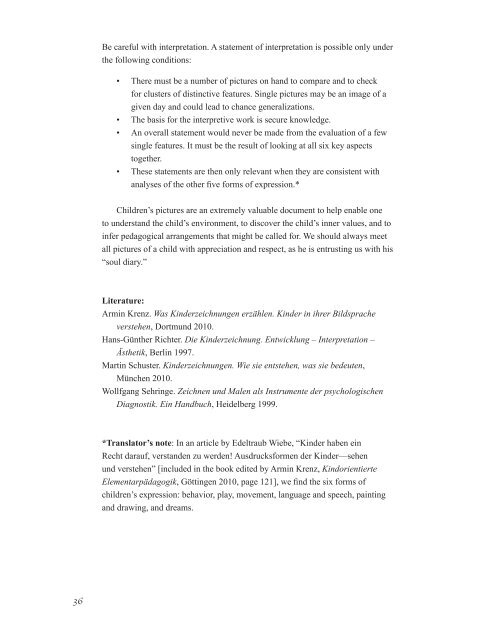Observing the Class Observing the Children - Research Institute for ...
Observing the Class Observing the Children - Research Institute for ...
Observing the Class Observing the Children - Research Institute for ...
Create successful ePaper yourself
Turn your PDF publications into a flip-book with our unique Google optimized e-Paper software.
36<br />
Be careful with interpretation. A statement of interpretation is possible only under<br />
<strong>the</strong> following conditions:<br />
• There must be a number of pictures on hand to compare and to check<br />
<strong>for</strong> clusters of distinctive features. Single pictures may be an image of a<br />
given day and could lead to chance generalizations.<br />
• The basis <strong>for</strong> <strong>the</strong> interpretive work is secure knowledge.<br />
• An overall statement would never be made from <strong>the</strong> evaluation of a few<br />
single features. It must be <strong>the</strong> result of looking at all six key aspects<br />
toge<strong>the</strong>r.<br />
• These statements are <strong>the</strong>n only relevant when <strong>the</strong>y are consistent with<br />
analyses of <strong>the</strong> o<strong>the</strong>r five <strong>for</strong>ms of expression.*<br />
<strong>Children</strong>’s pictures are an extremely valuable document to help enable one<br />
to understand <strong>the</strong> child’s environment, to discover <strong>the</strong> child’s inner values, and to<br />
infer pedagogical arrangements that might be called <strong>for</strong>. We should always meet<br />
all pictures of a child with appreciation and respect, as he is entrusting us with his<br />
“soul diary.”<br />
Literature:<br />
Armin Krenz. Was Kinderzeichnungen erzählen . Kinder in ihrer Bildsprache<br />
verstehen, Dortmund 2010.<br />
Hans-Gün<strong>the</strong>r Richter. Die Kinderzeichnung . Entwicklung – Interpretation –<br />
Äs<strong>the</strong>tik, Berlin 1997.<br />
Martin Schuster. Kinderzeichnungen . Wie sie entstehen, was sie bedeuten,<br />
München 2010.<br />
Wollfgang Sehringe. Zeichnen und Malen als Instrumente der psychologischen<br />
Diagnostik . Ein Handbuch, Heidelberg 1999.<br />
*Translator’s note: In an article by Edeltraub Wiebe, “Kinder haben ein<br />
Recht darauf, verstanden zu werden! Ausdrucks<strong>for</strong>men der Kinder—sehen<br />
und verstehen” [included in <strong>the</strong> book edited by Armin Krenz, Kindorientierte<br />
Elementarpädagogik, Göttingen 2010, page 121], we find <strong>the</strong> six <strong>for</strong>ms of<br />
children’s expression: behavior, play, movement, language and speech, painting<br />
and drawing, and dreams.

















